Significance of Velocity Slip in Convective Flow of Carbon Nanotubes
Abstract
:1. Introduction
2. Mathematical Formulation
3. Solutions by OHAM
4. Optimal Convergence-Control Parameters
5. Results and Discussion
6. Conclusions
- Both velocities and show reduction for higher values of velocity slip parameter .
- Larger stretching-strength parameter C presents an increase in radial velocity while opposite trend is noticed for azimuthal velocity and temperature .
- For higher estimations of the volume fraction both the velocity and temperatue field are enhanced.
- Temperature field is enhanced for larger values of the Biot number .
- Nusselt number Re is increased for larger values of volume fraction .
- Coefficient of skin-friction Re increases for higher volume fraction and velocity slip parameter
- The used technique for the solution’s development has advantages over the other in the sense of the following points:
- It is independent of small/large physical parameters.
- It provides a simple way to ensure the convergence of series solutions.
- It provides a large freedom to choose the base functions and related auxiliary linear operators.
Author Contributions
Funding
Conflicts of Interest
Nomenclature
| z | space coordinates [m] | w | velocity components [m·s] |
| fluid density [kg·m] | fluid dynamic viscosity [Pa·s] | ||
| nanofluids themal | kinematic nanofluid | ||
| conductivity [W·m·K] | viscosity [m·s] | ||
| basefluid themal | kinematic fluid | ||
| conductivity [W·m·K] | viscosity [m·s] | ||
| thermal diffusivity | thermal diffusivity | ||
| of base fluid [m·s] | of nanofluid [m·s] | ||
| hot fluid temperature [K] | ambient temperature [K] | ||
| C | stretching-strength parameter | CNTs thermal conductivity [W·m·K] | |
| velocity slip parameter | nanomaterial volume fraction | ||
| Biot number | Pr | Prandtl number | |
| dimensionless velocity | Nusselt number | ||
| skin friction coefficient | dimensionless variable | ||
| Re | local Reynolds number | dimensionless temperature | |
| CNTs | carbon nanotubes | arbitrary constants |
References
- Von Karman, T. Uber laminare and turbulente Reibung. ZAMM Z. Angew. Math. Mech. 1921, 1, 233–252. [Google Scholar] [CrossRef]
- Turkyilmazoglu, M.; Senel, P. Heat and mass transfer of the flow due to a rotating rough and porous disk. Int. J. Therm. Sci. 2013, 63, 146–158. [Google Scholar] [CrossRef]
- Rashidi, M.M.; Kavyani, N.; Abelman, S. Investigation of entropy generation in MHD and slip flow over rotating porous disk with variable properties. Int. J. Heat Mass Transf. 2014, 70, 892–917. [Google Scholar] [CrossRef]
- Turkyilmazoglu, M. Nanofluid flow and heat transfer due to a rotating disk. Comput. Fluids 2014, 94, 139–146. [Google Scholar] [CrossRef]
- Hatami, M.; Sheikholeslami, M.; Gangi, D.D. Laminar flow and heat transfer of nanofluids between contracting and rotating disks by least square method. Power Technol. 2014, 253, 769–779. [Google Scholar] [CrossRef]
- Mustafa, M.; Khan, J.A.; Hayat, T.; Alsaedi, A. On Bödewadt flow and heat transfer of nanofluids over a stretching stationary disk. J. Mol. Liq. 2015, 211, 119–125. [Google Scholar] [CrossRef]
- Sheikholeslami, M.; Hatami, M.; Ganji, D.D. Numerical investigation of nanofluid spraying on an inclined rotating disk for cooling process. J. Mol. Liq. 2015, 211, 577–583. [Google Scholar] [CrossRef]
- Hayat, T.; Muhammad, T.; Shehzad, S.A.; Alsaedi, A. On magnetohydrodynamic flow of nanofluid due to a rotating disk with slip effect: A numerical study. Comput. Methods Appl. Mech. Eng. 2017, 315, 467–477. [Google Scholar] [CrossRef]
- Choi, S.U.S.; Zhang, Z.G.; Yu, W.; Lockwood, F.E.; Grulke, E.A. Anomalous thermal conductivity enhancement in nanotube suspensions. Appl. Phys. Lett. 2001, 79, 2252. [Google Scholar] [CrossRef]
- Ramasubramaniam, R.; Chen, J.; Liu, H. Homogeneous carbon nanotube/polymer composites for electrical applications. Appl. Phys. Lett. 2003, 83, 2928. [Google Scholar] [CrossRef]
- Xue, Q.Z. Model for thermal conductivity of carbon nanotube-based composites. Phys. B Condens. Matter 2005, 368, 302–307. [Google Scholar] [CrossRef]
- Kamali, R.; Binesh, A. Numerical investigation of heat transfer enhancement using carbon nanotube-based non-Newtonian nanofluids. Int. Commun. Heat Mass Transf. 2010, 37, 1153–1157. [Google Scholar] [CrossRef]
- Wang, J.; Zhu, J.; Zhang, X.; Chen, Y. Heat transfer and pressure drop of nanofluids containing carbon nanotubes in laminar flows. Exp. Therm. Fluid Sci. 2013, 44, 716–721. [Google Scholar] [CrossRef]
- Haq, R.U.; Hammouch, Z.; Khan, W.A. Water-based squeezing flow in the presence of carbon nanotubes between two parallel disks. Therm. Sci. 2014, 20, 148. [Google Scholar] [CrossRef]
- Safaei, M.R.; Togun, H.; Vafai, K.; Kazi, S.N.; Badarudin, A. Investigation of heat transfer enhancement in a forward-facing contracting channel using FMWCNT nanofluids. Numer. Heat Transf. Part A 2014, 66, 1321–1340. [Google Scholar] [CrossRef]
- Ellahi, R.; Hassan, M.; Zeeshan, A. Study of natural convection MHD nanofluid by means of single and multi walled carbon nanotubes suspended in a salt water solutions. IEEE Trans. Nanotechnol. 2015, 14, 726–734. [Google Scholar] [CrossRef]
- Karimipour, A.; Taghipour, A.; Malvandi, A. Developing the laminar MHD forced convection flow of water/FMWNT carbon nanotubes in a microchannel imposed the uniform heat flux. J. Magn. Magn. Mater. 2016, 419, 420–428. [Google Scholar] [CrossRef]
- Hayat, T.; Hussain, Z.; Muhammad, T.; Alsaedi, A. Effects of homogeneous and heterogeneous reactions in flow of nanofluids over a nonlinear stretching surface with variable surface thickness. J. Mol. Liq. 2016, 221, 1121–1127. [Google Scholar] [CrossRef]
- Hayat, T.; Muhammad, K.; Farooq, M.; Alsaedi, A. Unsteady squeezing flow of carbon nanotubes with convective boundary conditions. PLoS ONE 2016, 11, e0152923. [Google Scholar] [CrossRef]
- Hayat, T.; Haider, F.; Muhammad, T.; Alsaedi, A. On Darcy-Forchheimer flow of carbon nanotubes due to a rotating disk. Int. J. Heat Mass Transf. 2017, 112, 248–254. [Google Scholar] [CrossRef]
- Akbar, N.S.; Khan, Z.H.; Nadeem, S. The combined effects of slip and convective boundary conditions on stagnation-point flow of CNT suspended nanofluid over a stretching sheet. J. Mol. Liq. 2014, 196, 21–25. [Google Scholar] [CrossRef]
- Arani, A.A.A.; Akbari, O.A.; Safaei, M.R.; Marzban, A.; Alrashed, A.A.A.A.; Ahmadi, G.R.; Nguyen, T.K. Heat transfer improvement of water/single-wall carbon nanotubes (SWCNT) nanofluid in a novel design of a truncated double-layered microchannel heat sink. Int. J. Heat Mass Transf. 2017, 113, 780–795. [Google Scholar] [CrossRef]
- Goodarzi, M.; Javid, S.; Sajadifar, A.; Nojoomizadeh, M.; Motaharipour, S.H.; Bach, Q.V.; Karimipour, A. Slip velocity and temperature jump of a non-Newtonian nanofluid, aqueous solution of carboxy-methyl cellulose/aluminum oxide nanoparticles, through a microtube. Int. J. Numer. Methods Heat Fluid Flow 2018. [Google Scholar] [CrossRef]
- Ellahi, R.; Zeeshan, A.; Hussain, F.; Asadollahi, A. Peristaltic blood flow of couple stress fluid suspended with nanoparticles under the influence of chemical reaction and activation energy. Symmetry 2019, 11, 276. [Google Scholar] [CrossRef]
- Suleman, M.; Ramzan, M.; Ahmad, S.; Lu, D.; Muhammad, T.; Chung, J.D. A numerical simulation of silver-water nanofluid flow with impacts of Newtonian heating and homogeneous-heterogeneous reactions past a nonlinear stretched cylinder. Symmetry 2019, 11, 295. [Google Scholar] [CrossRef]
- Liao, S.J. An optimal homotopy-analysis approach for strongly nonlinear differential equations. Commun. Nonlinear. Sci. Numer. Simul. 2010, 15, 2003–2016. [Google Scholar] [CrossRef]
- Dehghan, M.; Manafian, J.; Saadatmandi, A. Solving nonlinear fractional partial differential equations using the homotopy analysis method. Numer. Meth. Part. Diff. Equ. 2010, 26, 448–479. [Google Scholar] [CrossRef]
- Malvandi, A.; Hedayati, F.; Domairry, G. Stagnation point flow of a nanofluid toward an exponentially stretching sheet with nonuniform heat generation/absorption. J. Thermodyn. 2013, 2013, 764827. [Google Scholar] [CrossRef]
- Abbasbandy, S.; Hayat, T.; Alsaedi, A.; Rashidi, M.M. Numerical and analytical solutions for Falkner-Skan flow of MHD Oldroyd-B fluid. Int. J. Numer. Methods Heat Fluid Flow 2014, 24, 390–401. [Google Scholar] [CrossRef]
- Sheikholeslami, M.; Hatami, M.; Ganji, D.D. Micropolar fluid flow and heat transfer in a permeable channel using analytic method. J. Mol. Liq. 2014, 194, 30–36. [Google Scholar] [CrossRef]
- Hayat, T.; Muhammad, T.; Alsaedi, A.; Alhuthali, M.S. Magnetohydrodynamic three-dimensional flow of viscoelastic nanofluid in the presence of nonlinear thermal radiation. J. Magn. Magn. Mater. 2015, 385, 222–229. [Google Scholar] [CrossRef]
- Turkyilmazoglu, M. An effective approach for evaluation of the optimal convergence control parameter in the homotopy analysis method. Filomat 2016, 30, 1633–1650. [Google Scholar] [CrossRef]
- Zeeshan, A.; Majeed, A.; Ellahi, R. Effect of magnetic dipole on viscous ferro-fluid past a stretching surface with thermal radiation. J. Mol. Liq. 2016, 215, 549–554. [Google Scholar] [CrossRef]
- Hayat, T.; Abbas, T.; Ayub, M.; Muhammad, T.; Alsaedi, A. On squeezed flow of Jeffrey nanofluid between two parallel disks. Appl. Sci. 2016, 6, 346. [Google Scholar] [CrossRef]
- Muhammad, T.; Alsaedi, A.; Shehzad, S.A.; Hayat, T. A revised model for Darcy-Forchheimer flow of Maxwell nanofluid subject to convective boundary condition. Chin. J. Phys. 2017, 55, 963–976. [Google Scholar] [CrossRef]
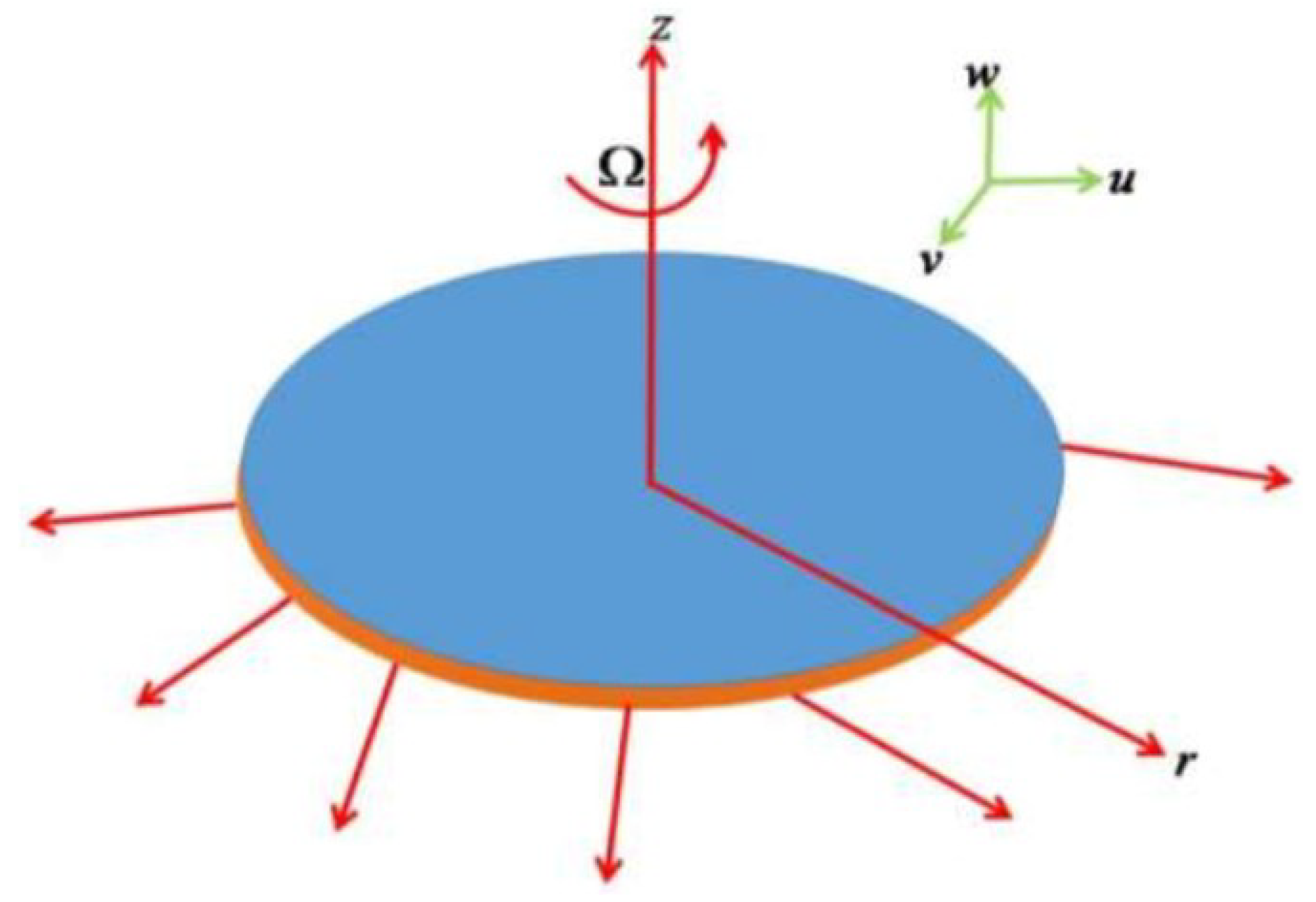

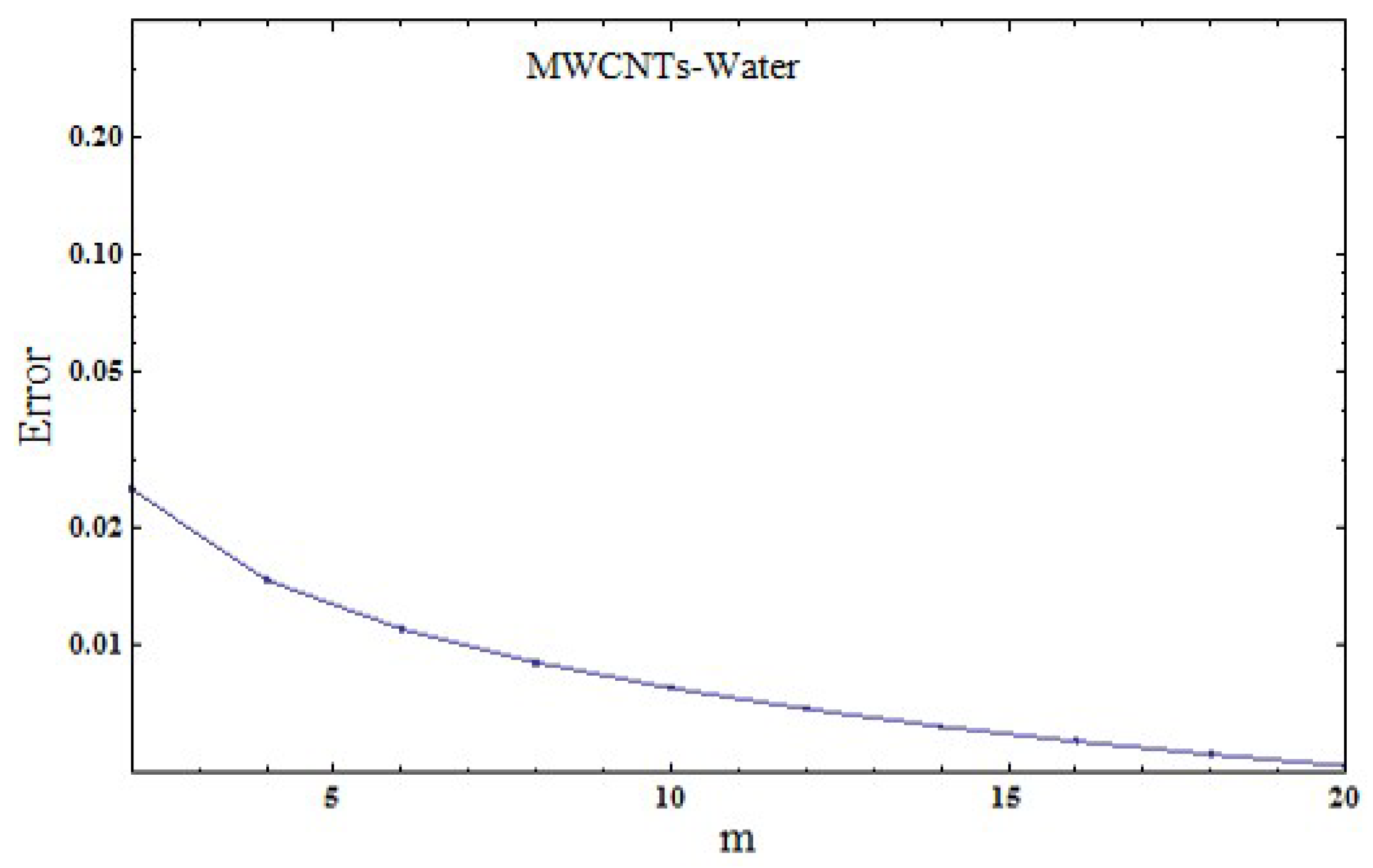

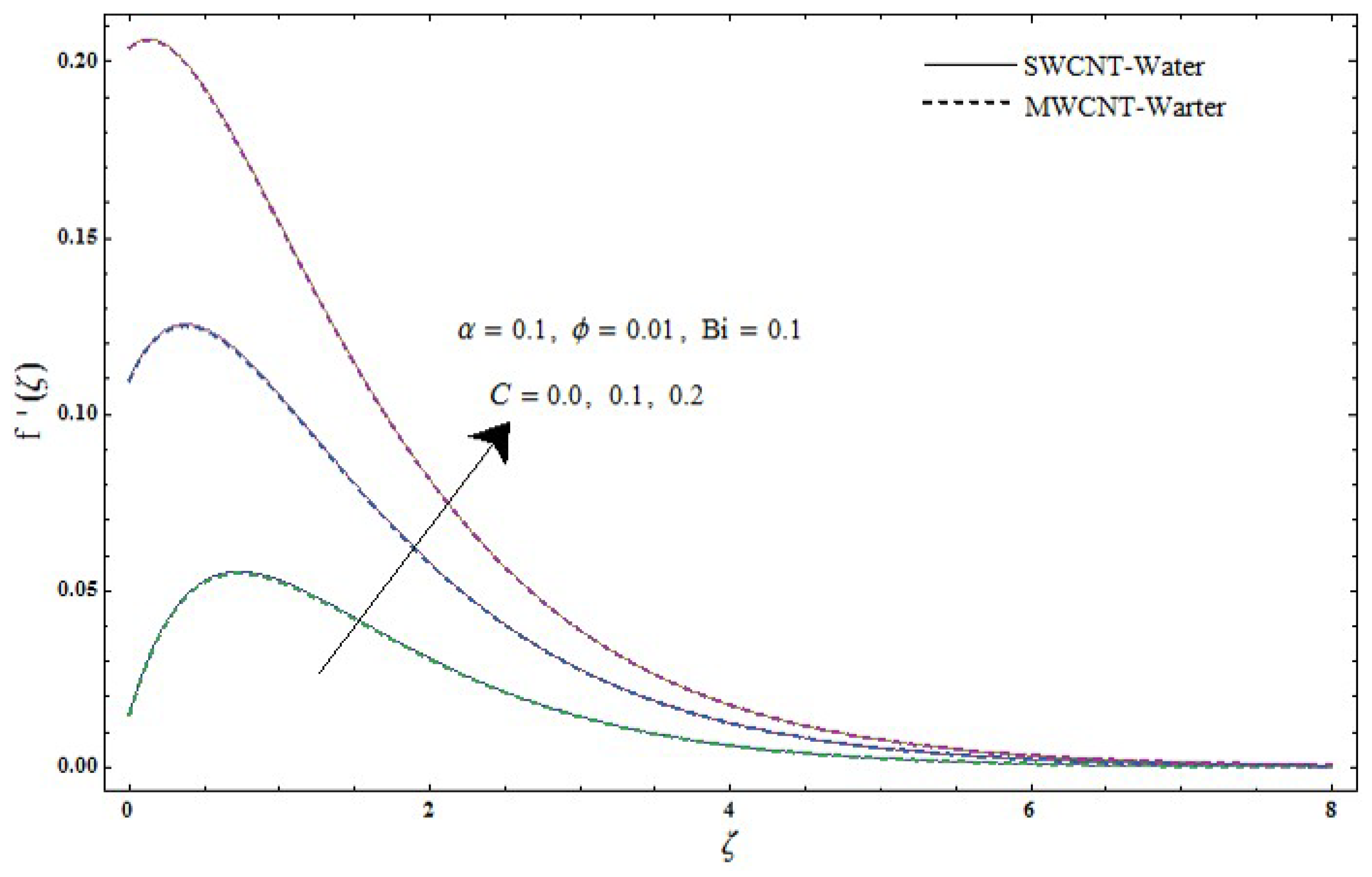
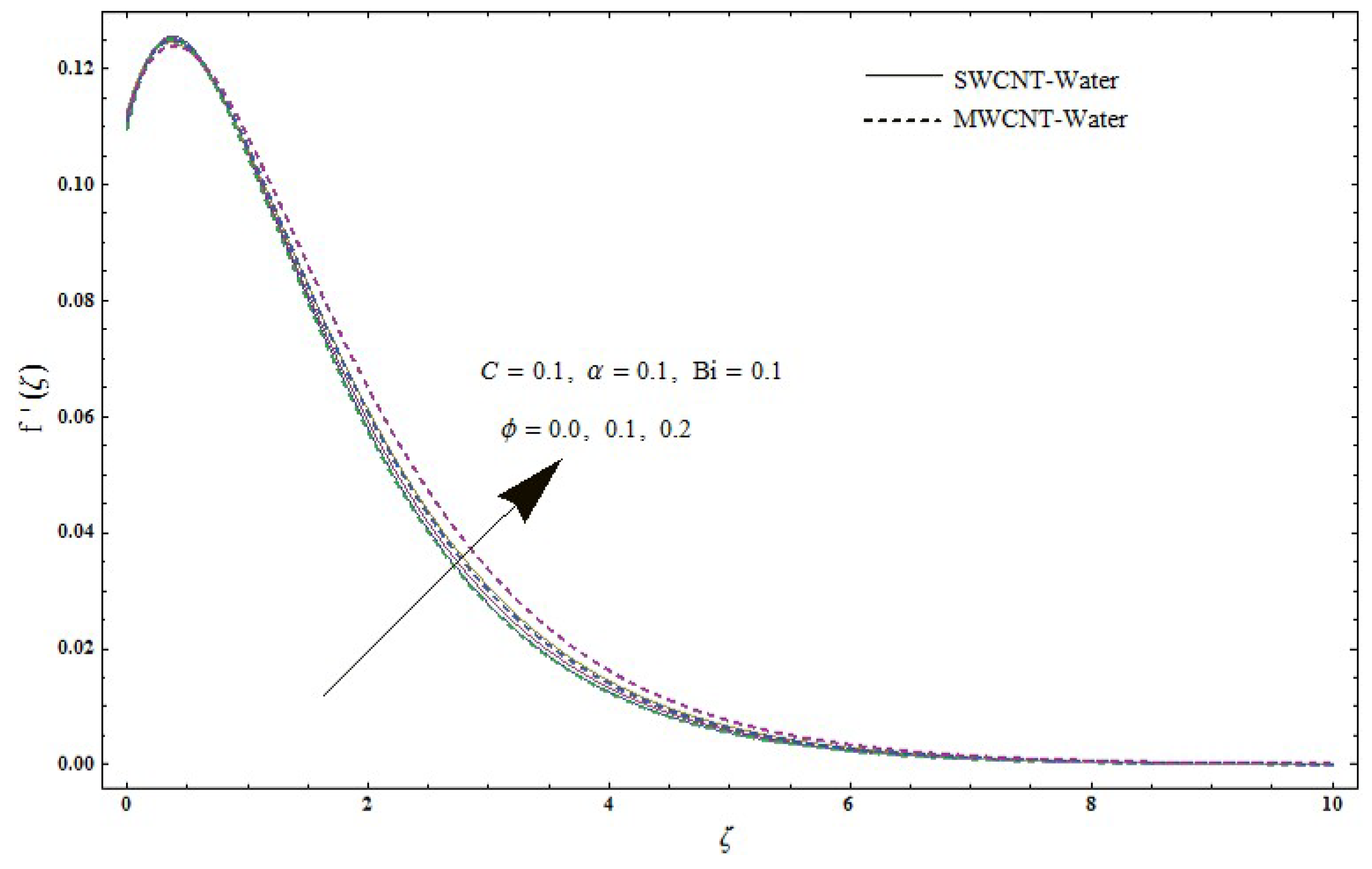
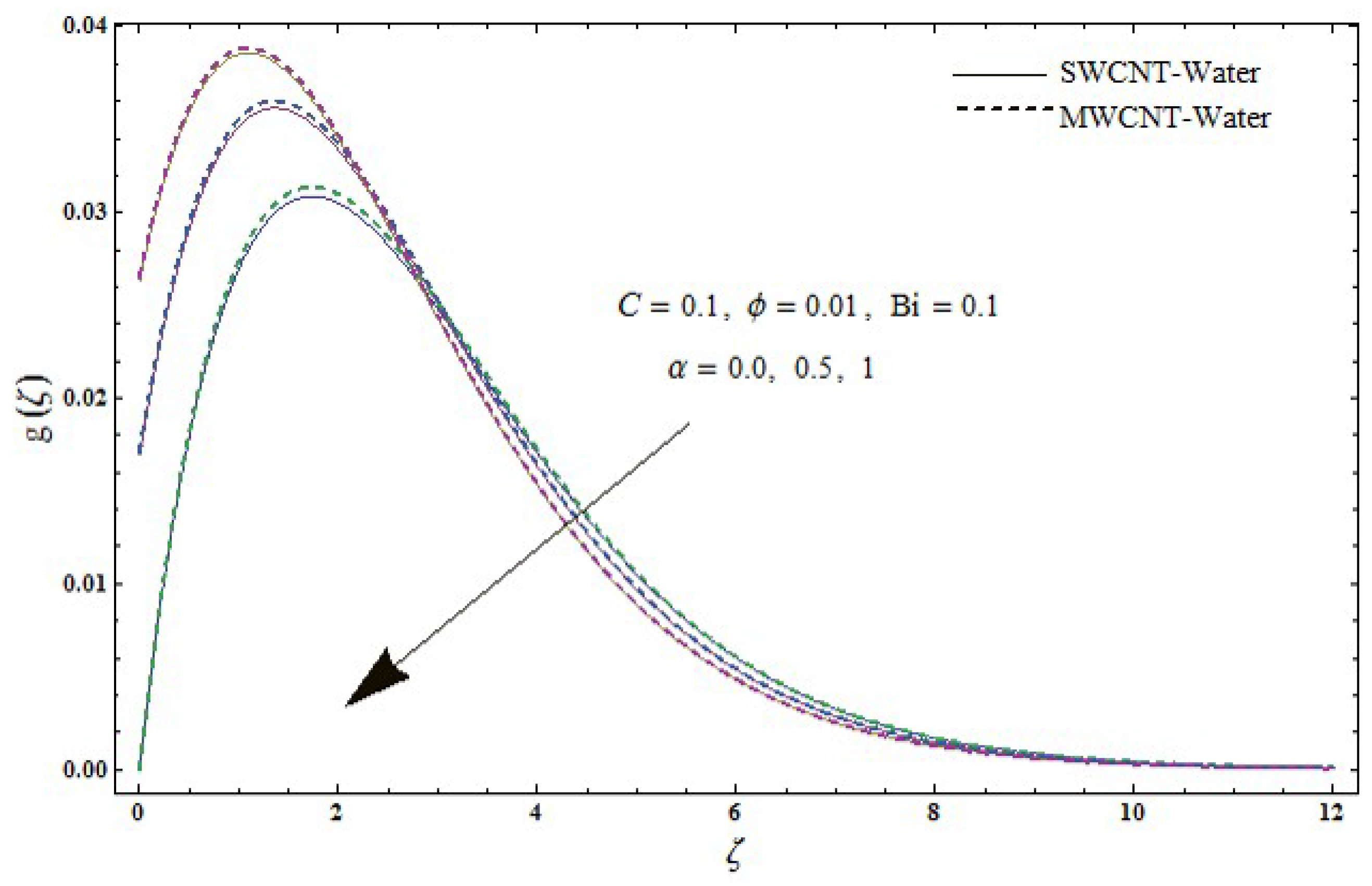
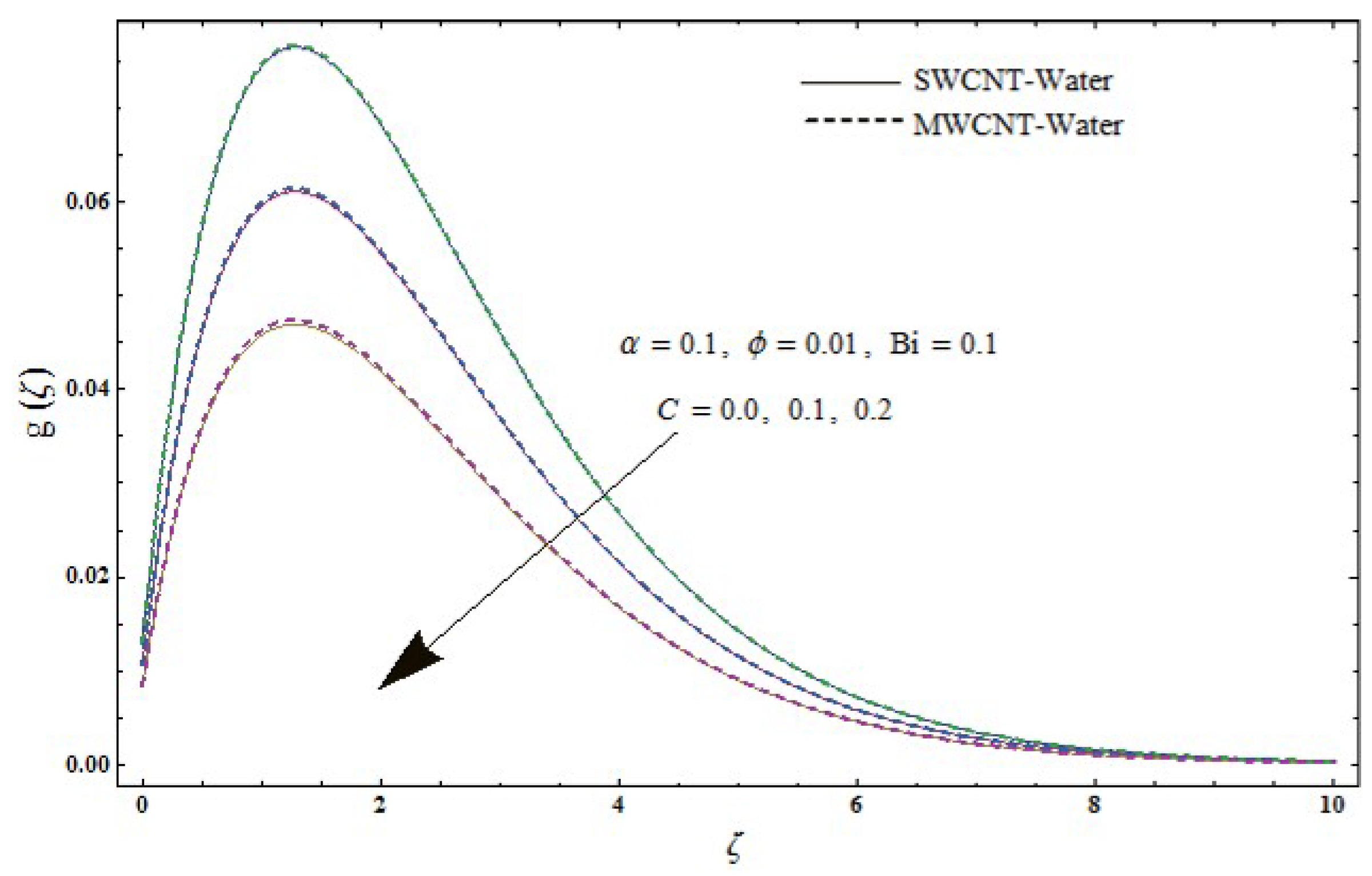


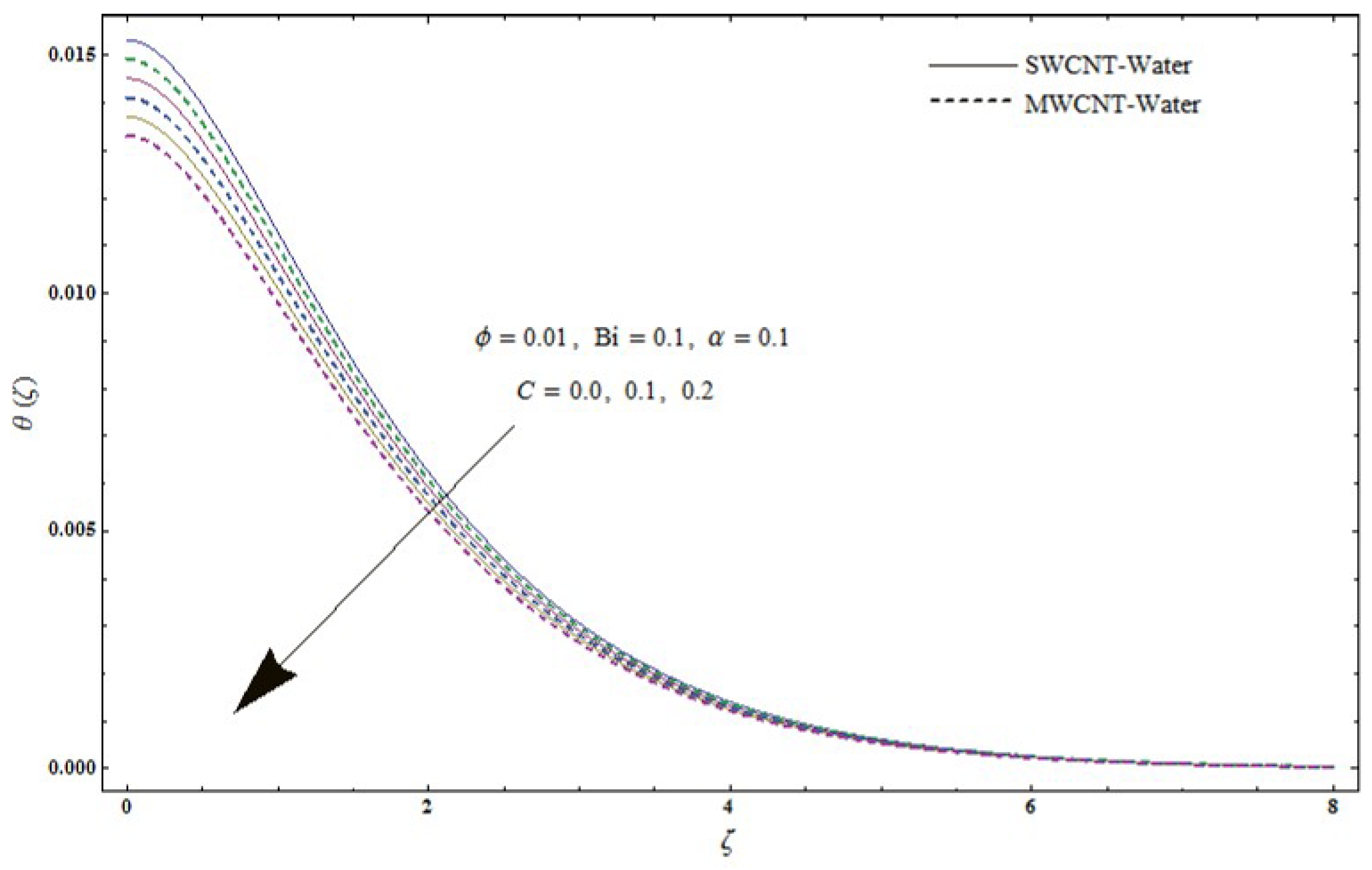
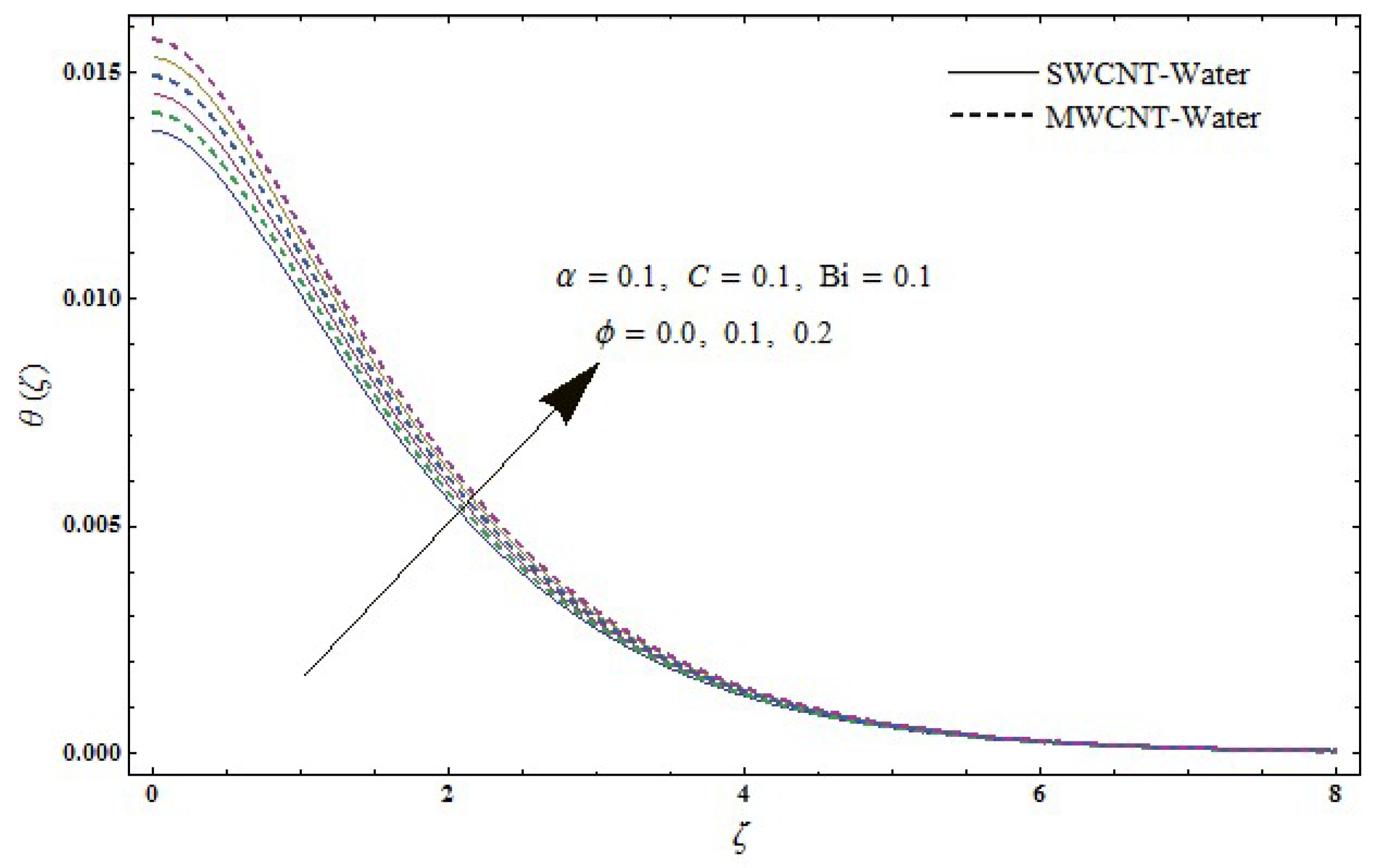
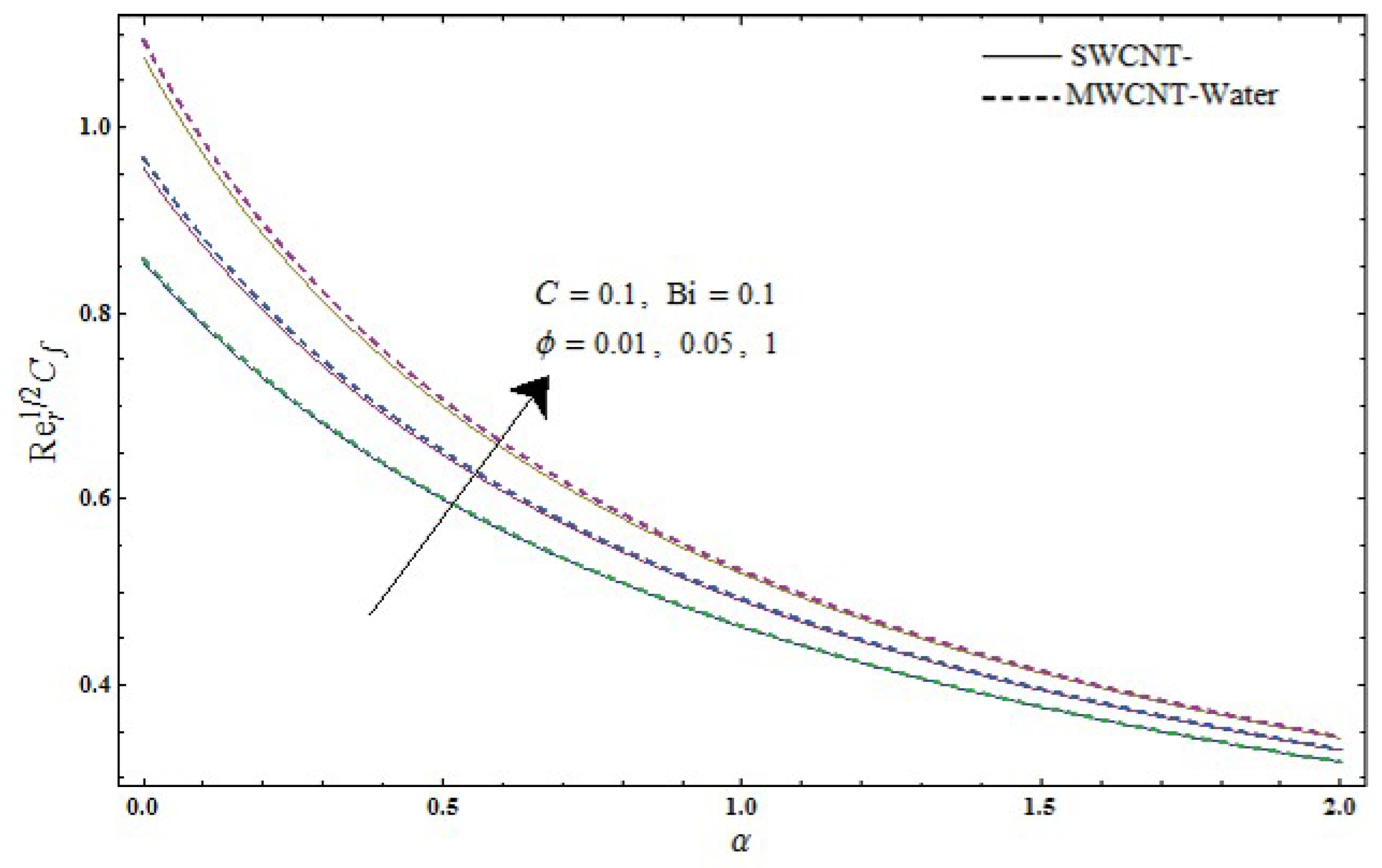
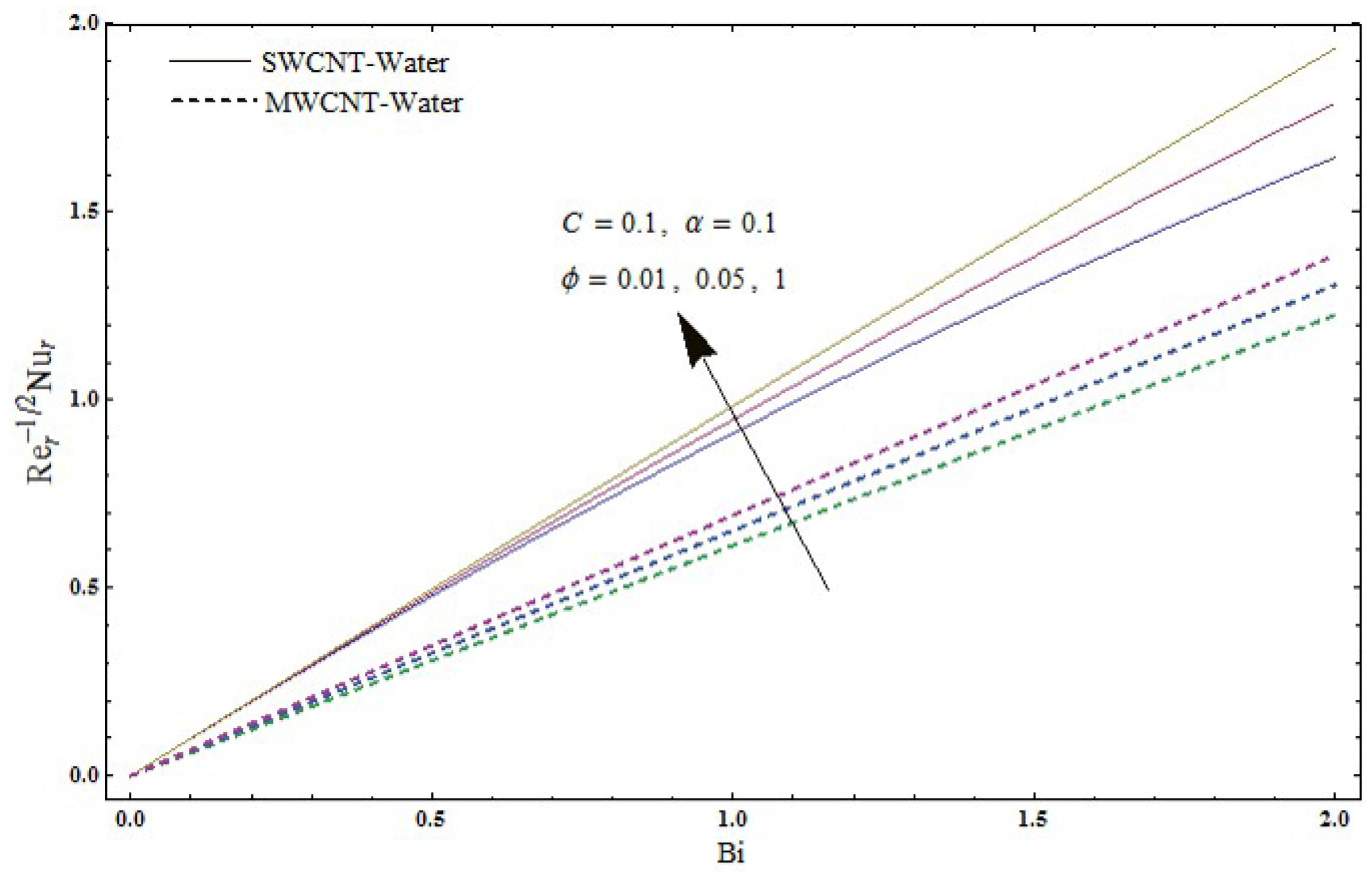
| Physical Features | Water | CNT | |
|---|---|---|---|
| SWCNTs | MWCNTs | ||
| (kg/m | 2600 | 1600 | |
| k (W/mK) | 6600 | 3000 | |
| (J/kgK) | 4179 | 425 | 796 |
| m | |||
|---|---|---|---|
| 2 | |||
| 6 | |||
| 10 | |||
| 14 | |||
| 18 | |||
| 20 |
| m | |||
|---|---|---|---|
| 2 | |||
| 6 | |||
| 10 | |||
| 14 | |||
| 18 | |||
| 20 |
© 2019 by the authors. Licensee MDPI, Basel, Switzerland. This article is an open access article distributed under the terms and conditions of the Creative Commons Attribution (CC BY) license (http://creativecommons.org/licenses/by/4.0/).
Share and Cite
Alshomrani, A.S.; Ullah, M.Z. Significance of Velocity Slip in Convective Flow of Carbon Nanotubes. Symmetry 2019, 11, 679. https://doi.org/10.3390/sym11050679
Alshomrani AS, Ullah MZ. Significance of Velocity Slip in Convective Flow of Carbon Nanotubes. Symmetry. 2019; 11(5):679. https://doi.org/10.3390/sym11050679
Chicago/Turabian StyleAlshomrani, Ali Saleh, and Malik Zaka Ullah. 2019. "Significance of Velocity Slip in Convective Flow of Carbon Nanotubes" Symmetry 11, no. 5: 679. https://doi.org/10.3390/sym11050679
APA StyleAlshomrani, A. S., & Ullah, M. Z. (2019). Significance of Velocity Slip in Convective Flow of Carbon Nanotubes. Symmetry, 11(5), 679. https://doi.org/10.3390/sym11050679





